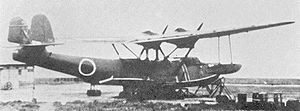Yokosuka H5Y Video - Picture

|
|
Yokosuka H5Y

Aircraft Picture - Yokosuka H5Y Type 99 Flying Boat "Cherry"
Role: Flying boat
Manufacturer: Yokosuka
First flight: 1936
Introduction: 1939
Primary user: IJN Air Service
Produced: 1938-1941
Number built: 20
The Yokosuka H5Y or Type 99 Flying Boat (ä¹ä¹å¼é£è¡è, 99shiki hikÅtei) (allied code name Cherry) was an Imperial Japanese Navy flying boat. Only 20 were built between 1936 and 1941. Yokosuka built the aircraft at their Dai-Juichi Kaigun Kokusho location, the Naval Air Arsenal.
Design and development
The H5Y was designed by Yokosuka to meet an Imperial Japanese Navy requirement for a twin-engine maritime reconnaissance flying boat, which was intended to match the performance of contemporary four-engine flying boats, while being cheaper to build and easier to maintain. Two prototypes were built at the 11th Naval Arsenal, Hiro, being completed in 1936.
The H5Y was a twin-engine parasol wing aircraft, and thus resembled a scaled-down version of the Kawanishi H6K "Mavis". Performance was found to be poor however, with the aircraft underpowered and suffering from structural problems which delayed production .
Operational history
The H5Y was accepted for production in 1938 as the Type 99 Flying Boat, Model 11, production deliveries starting in 1939. However, production was quickly cancelled owing to the poor performance, only 20 being built.
Although some were used for coastal anti-submarine patrols early in World War II, they were quickly transferred to second line duties such as transport or training.
Variants
H5Y 2 Prototypes constructed in Hiro Navy Arsenal H5Y1 (Type 99 Navy Flying Boat, Model 11) Production model, 18 built.
Operators
Japan
Imperial Japanese Navy Air Service
Specifications (Yokosuka H5Y1)
Data from Warplanes of the Second World War, Volume Five: Flying Boats
General characteristics
Crew: 6
Length: 20.53 m (67 ft 4 in)
Wingspan: 31.57 m (103 ft 7½in)
Height: 6.71 m (22 ft 0 in)
Wing area: 107.7 m² (1,159 ft²)
Empty weight: 7,070 kg (15,554 lb)
Max takeoff weight: 11,500 kg (25,353 lb)
Powerplant: 2 x Mitsubishi MK1A Shinten-21 14-cylinder air-cooled radials, 895 kW (1,200 hp) each
Performance
Maximum speed: 303 km/h (163 kn, 188 mph)
Range: 4,800 km (2,591 nmi, 2,980 mi)
Service ceiling: 5,200 m (17,000 ft)
Endurance: 26 hr
Climb to 3,000 m (9,850 ft): 24 min
Armament
Guns: 3x 7.7 mm (.303 in) machine guns
Bombs: 2x 250 kg (552 lb) bombs
Bibliography
Donald, David (Editor). The Encyclopedia of World Aircraft. Aerospace Publishing, 1997. ISBN 1-85605-375-X.
Francillon, Ph.D., René J. Japanese Aircraft of the Pacific War. London: Putnam & Company Ltd., 1970 (2nd edition 1979). ISBN 0-370-30251-6.
Green, William. Warplanes of the Second World War, Volume Five: Flying Boats. London: Macdonald & Co.(Publishers) Ltd., 1962 (5th impression 1972). ISBN 0-356-01449-5.
Yokosuka H5Y Pictures
More airplane video.
Source: WikiPedia